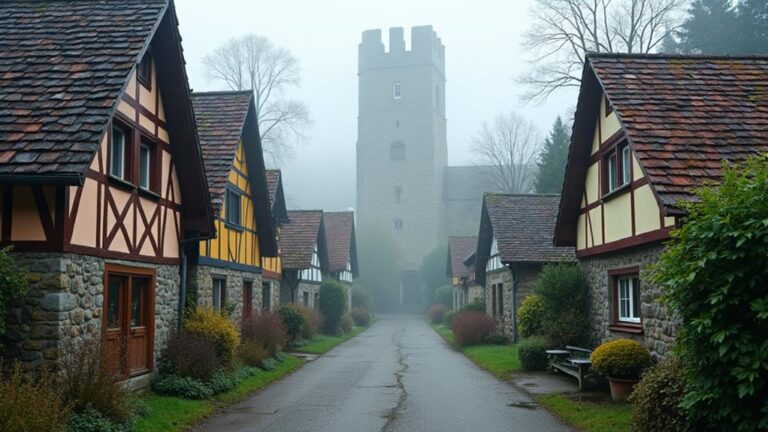As you plan your trip to Lisbon, Portugal in November, you're likely curious about the best ways to experience the city's unique blend of history, culture, and natural beauty. With mild autumn weather and fewer tourists, November is an ideal time to explore Lisbon's iconic landmarks and hidden gems. From historic sites like the Belem Tower and Jeronimos Monastery to lively neighborhoods and markets, there's no shortage of exciting things to see and do. But what are the top 10 experiences you shouldn't miss? Let's start with a few must-visit attractions that set the tone for your Lisbon adventure.
Contents
Key Takeaways
- Visit the Belem Tower and Jeronimos Monastery to experience Lisbon's rich history and Manueline architecture.
- Explore the historic neighborhoods of Alfama and Castle of Sao Jorge for scenic views and Moorish influence.
- Enjoy traditional Portuguese cuisine like Bacalhau à Brás, Caldo Verde, and Pastel de Nata at local restaurants.
- Attend a Fado music performance to experience Lisbon's melancholic soul and traditional music.
- Take a ride on Tram 28 to see Lisbon's picturesque hills and historic landmarks in a vintage tram.
Explore Belem Tower
What's the first thing that comes to mind when you think of Lisbon, Portugal? For many, it's the stunning Belem Tower, a medieval fortress standing proudly on the Tagus River.
As you approach the tower, you can't help but be captivated by its intricate Manueline architecture and the breathtaking river views that surround it.
As you explore the tower, you'll discover its rich history, which dates back to the 16th century.
Belem Tower was built to commemorate Vasco da Gama's voyage to India and to serve as a defensive structure for the port of Lisbon.
As you climb the narrow staircases and explore the tower's nooks and crannies, you'll uncover some of its secrets, including the symbolic stone carvings that adorn its walls.
Take a moment to gaze out at the Tagus River from the tower's battlements, and you'll understand why Belem Tower is one of Lisbon's most beloved landmarks.
The views are simply stunning, with the river stretching out as far as the eye can see.
Whether you're a history buff, an architecture enthusiast, or simply looking for a unique perspective on the city, Belem Tower is a must-visit destination in Lisbon.
Attend Lisbon Festival
Every June, Lisbon transforms into a vibrant celebration of music, dance, and theater with the Lisbon Festival, a month-long extravaganza that draws visitors from all over the world.
As you immerse yourself in the festival atmosphere, you'll discover a unique cultural fusion that showcases the city's rich heritage and its ability to blend traditional and modern elements.
While attending the Lisbon Festival, you can expect to experience:
- A diverse range of performances, from classical music and opera to contemporary dance and theater productions
- A showcase of traditional Portuguese music and dance, highlighting the country's unique cultural identity
- Collaborations between local and international artists, resulting in innovative and captivating performances
- A lively atmosphere that spills out into the streets, with food, drink, and merriment available at every turn
As you explore the festival, you'll be struck by the energy and creativity that permeates every aspect of the event.
Whether you're interested in music, dance, or theater, the Lisbon Festival has something to offer, making it a must-visit experience for anyone traveling to Lisbon in June.
Visit Jeronimos Monastery
As you step into the Jeronimos Monastery, you'll be surrounded by the intricate Manueline architecture that's synonymous with Lisbon.
This breathtaking monument, a masterpiece of 16th-century design, was built to commemorate Vasco da Gama's voyage to India.
You'll soon discover that Jeronimos Monastery is a treasure trove of historical significance, art, and stunning architecture, making it a must-visit destination in Lisbon.
Architecture and Design
Stepping into Lisbon's historic district of Belém, you're immediately struck by the stunning Manueline architecture of the Jerónimos Monastery.
This iconic landmark is a testament to the country's rich cultural heritage and its ability to blend different styles and influences.
The monastery's intricate stone carvings, ornate facades, and majestic cloisters make it a masterpiece of urban landscapes.
The Jerónimos Monastery is also notable for its influence on Modernist movements, particularly in the early 20th century.
Its unique blend of Gothic, Renaissance, and Islamic styles has inspired architects and designers around the world.
As you explore the monastery, you'll notice the following architectural features:
- Elaborate stone carvings and ornate facades that adorn the exterior of the monastery
- Majestic cloisters with intricate arches and columns that create a sense of tranquility and calm
- A blend of Gothic, Renaissance, and Islamic styles that reflect the cultural heritage of Portugal
- A grandiose interior with soaring vaults and stunning stained-glass windows that filter in the light
As you marvel at the monastery's stunning architecture, you'll gain a deeper appreciation for the cultural and artistic heritage of Lisbon.
Historical Significance and Art
While exploring the Jerónimos Monastery, you'll discover that it's a historical treasure trove, rich in stories and symbolism that reveal the complexities of Portugal's past.
This stunning example of Manueline architecture is a testament to the country's rich heritage, and its intricate details will leave you in awe.
As you wander through the monastery's cloisters and chapels, you'll come across exquisite Baroque paintings that adorn the walls and ceilings, showcasing the artistic talents of Portugal's finest artists.
Delve deeper into the monastery's history, and you'll uncover the remnants of a Roman temple that once stood on the site.
Roman mosaics, skillfully restored to their former glory, provide a glimpse into the lives of the ancient Romans who once inhabited the area.
The monastery's museum also houses a collection of artifacts and relics, including ornate tombs and sculptures, which offer a fascinating insight into Portugal's historical significance.
As you explore the Jerónimos Monastery, you'll begin to appreciate the depth of Portugal's cultural heritage and the artistic treasures that lie within.
Visiting the Monument
You'll discover that visiting the Jerónimos Monastery is an experience like no other, one that seamlessly combines history, architecture, and art in a single, breathtaking location.
As you step into this magnificent Monument, you'll be struck by the sheer scale and grandeur of its design.
- * *
- As you explore the Jerónimos Monastery, you'll uncover a rich Monument history that spans centuries, from its founding in 1502 to its current status as a UNESCO World Heritage Site.
- Marvel at the intricate stone carvings and ornate details that adorn the Monument architecture, a testament to the skill and craftsmanship of the master builders who created this masterpiece.
- Visit the tomb of Vasco da Gama, the famous Portuguese explorer, and learn about his voyages and the impact they'd on the world.
- Take a moment to appreciate the stunning cloisters, with their delicate arches and tranquil atmosphere, a perfect spot to reflect on the beauty and significance of this incredible Monument.
Take Tram 28 Ride
As the iconic yellow tram winds its way through Lisbon's picturesque hills and historic neighborhoods, you're in for a treat on the famous Tram 28 ride.
This vintage tram has been in operation since the early 20th century, and its tram history is still visible in the vehicles that run today. The tram's original cars date back to the 1930s, but they've been restored to maintain their historical charm.
As you ride Tram 28, you'll pass by some of Lisbon's most iconic landmarks, including the Castle of São Jorge, the National Pantheon, and the picturesque neighborhood of Alfama.
You'll also get a glimpse into the city's daily life, as the tram takes you through narrow streets and picturesque alleys. Be prepared for some steep hills and sharp turns, but don't worry – the tram's experienced drivers know the route like the back of their hand.
Take a moment to sit back, relax, and enjoy the views as you ride Tram 28 through the heart of Lisbon. With its unique tram history and stunning views of the city's landmarks, this is an experience you won't want to miss during your visit to Lisbon in November.
Discover Local Markets
Immersing yourself in Lisbon's vibrant atmosphere means exploring the local markets, where the city's authentic soul comes alive in a kaleidoscope of sights, sounds, and aromas.
As you wander through the stalls, you'll discover a world of fresh produce, seasonal goods, and unique souvenirs.
From the bustling Mercado da Ribeira to the charming Campo de Ourique Market, each market offers a distinct experience that's sure to captivate your senses.
- Visit the Mercado da Ribeira, a historic market offering a wide range of fresh produce, cheeses, and baked goods.
- Explore the Campo de Ourique Market, a charming neighborhood market filled with seasonal goods, flowers, and local specialties.
- Browse the stalls at the Feira da Ladra, a bustling flea market where you can find everything from vintage clothing to antique furniture.
- Stop by the Mercado de Campo de Ourique, a modern market offering a variety of fresh produce, meats, and prepared foods.
Enjoy Traditional Cuisine
As you wander Lisbon's streets, your taste buds will be tantalized by the city's traditional cuisine, a delicious reflection of its rich history and cultural heritage.
You'll want to sample local specialties like bacalhau à brás, a hearty cod dish, and frango grelhado, a mouthwatering grilled chicken.
From sweet pastries to fresh seafood, Lisbon's culinary landscape is a treasure trove of flavors waiting for you to explore.
Taste Local Specialties
Dive into Lisbon's food scene and you'll discover a world of flavors that blend traditional Portuguese cuisine with modern twists.
As you explore the city, you'll find a variety of local specialties that showcase the country's rich gastronomic heritage.
From hearty meat dishes to fresh seafood, every bite is a taste sensation.
Some must-try local specialties include:
- Bacalhau à brás: a codfish dish made with shredded cod, onions, potatoes, and scrambled eggs
- Caldo verde: a comforting soup made with potatoes, onions, kale, and sausage
- Cataplana de peixe: a fish stew cooked in a copper cataplana pot with a variety of seafood and spices
- Leitão: a classic Portuguese dish featuring roasted suckling pig
When visiting Lisbon in November, be sure to check out the city's food festivals, which offer a chance to sample local specialties and wines.
Wine tastings are also a great way to experience the country's renowned wines, including Port and Vinho Verde.
With its rich culinary heritage and modern twists, Lisbon's food scene is sure to delight even the most discerning palates.
Savor Traditional Pastries
Indulge in Lisbon's traditional pastries, and you'll be treated to a world of flaky crusts, sweet fillings, and delicate flavors.
The art of pastry making is a long-standing tradition in Lisbon, with many pastelarias (pastry shops) throughout the city offering a wide variety of sweet treats.
Be sure to try a classic Pastel de Nata, a small, flaky egg tart that's a staple of Portuguese pastry making. The combination of the crispy pastry and the creamy egg filling is sure to give you a sugar rush.
Other must-try pastries include the Fios de Ovos, thin strands of egg yolk cooked in a sweet syrup, and the Bola de Bolacha, a rich chocolate cake made with ground almonds.
Visit the famous Pastéis de Belém, a historic pastry shop that's been perfecting the art of pastry making since 1837.
With a wide variety of traditional pastries to choose from, you'll want to try them all. Take your time, and indulge in the sweet flavors of Lisbon's traditional pastries. You won't be disappointed.
Explore Seafood Options
Portugal's extensive coastline makes it a seafood lover's paradise, and Lisbon is the perfect place to sample the freshest catches.
You'll find an array of seafood markets, such as the Mercado da Ribeira, offering an incredible selection of fresh seafood.
This historic market, located in the heart of Lisbon, is a must-visit destination for seafood enthusiasts.
When you're ready to indulge in some of Lisbon's freshest catches, consider the following dishes:
- *Bacalhau à Brás*: a traditional Portuguese dish made with shredded cod, potatoes, onions, and scrambled eggs.
- *Arroz de Marisco*: a flavorful seafood rice dish loaded with a variety of seafood, including shrimp, mussels, and clams.
- *Caldeirada*: a hearty fish stew made with a variety of fish and seafood, such as cod, hake, and mussels.
- *Grilled Sardines*: a classic Portuguese dish, often served with a side of boiled potatoes and vegetables.
Lisbon's seafood scene is a culinary experience you won't want to miss.
With its rich flavors, aromas, and stunning presentation, you'll be hooked on the city's fresh catches in no time.
Hike to Castle Sao Jorge
Tucked away in the historic neighborhood of Alfama, Castle Sao Jorge is a must-visit attraction in Lisbon, and the best way to experience it's to hike to the top.
As you make your way up, you'll be surrounded by the castle's imposing walls, which have stood the test of time since the 11th century.
The Moorish influence is evident in the castle's architecture, with its rugged stone façades and imposing battlements.
The hike itself is relatively steep, but the scenic views of Lisbon's rooftops and the Tagus River make it well worth the effort.
As you climb, you'll notice the castle's strategic location, perched atop a hill overlooking the city.
This vantage point allowed the castle's former occupants to survey their surroundings and defend against invaders.
Once you reach the top, you can explore the castle's courtyards, towers, and gardens, taking in the rich history and stunning views.
Don't forget to bring your camera to capture the breathtaking vistas of Lisbon spread out before you.
The hike to Castle Sao Jorge is an unforgettable experience that will leave you with lasting memories of your time in Lisbon.
Visit National Pantheon
As you make your way to the National Pantheon in Lisbon, you'll be visiting a site steeped in historical significance, where Portugal's most revered citizens are honored.
You'll be surrounded by the stunning Baroque architecture of the 17th-century Church of Santa Engrácia, which now serves as the National Pantheon.
The intricate design features and ornate details of this iconic building will leave you in awe, and it's here that you can pay your respects to Portugal's national heroes.
Historical Significance Explained
When you step into the stunning Baroque interior of the National Pantheon, you're not just visiting a beautifully crafted church – you're walking into a treasure trove of Portugal's history and culture.
This magnificent building is a testament to the country's rich heritage, with Moorish influences evident in its architecture and ornate decorations.
As you explore the Pantheon, you'll discover the resting place of some of Portugal's most revered figures, including writers, explorers, and politicians.
- The National Pantheon is the final resting place of famous Portuguese explorer Vasco da Gama, who discovered the sea route to India in 1498.
- You'll also find the tombs of celebrated Portuguese writers, such as Luís de Camões, who wrote the epic poem "Os Lusíadas," which tells the story of Portugal's voyages of discovery.
- The Pantheon is also home to the tombs of Portuguese legends, including the country's first president, Manuel de Arriaga, and the famous fado singer, Amália Rodrigues.
- As you wander through the Pantheon, you'll be surrounded by intricate stone carvings, gilded details, and stunning stained-glass windows, all of which pay tribute to Portugal's rich history and cultural heritage.
Architectural Design Features
The National Pantheon's architectural design is just as captivating as its rich history, with an impressive blend of Baroque and Neoclassical styles that reflect the country's cultural influences.
As you step inside, you're immediately struck by the stunning Baroque details, from the intricate stone carvings to the ornate frescoes that adorn the ceiling. The building's grand dome, designed by Italian architect João Antunes, takes center stage, with its imposing presence drawing your gaze upward.
Take a closer look around, and you'll notice subtle Rococo influences in the delicate moldings and ornate gilding that add a touch of whimsy to the space.
The Neoclassical elements, on the other hand, bring a sense of balance and harmony to the design, with clean lines and classical proportions that evoke a sense of timelessness.
As you explore the National Pantheon, you'll be struck by the way these different styles come together to create a truly unique and breathtaking architectural experience.
The result is a building that's not only a testament to Portugal's rich history but also a work of art that continues to inspire and awe visitors to this day.
Stroll Through Alfama
Beyond Lisbon's bustling city center lies the historic neighborhood of Alfama, waiting to be discovered on foot.
As you wander through Alfama's charming streets, you'll uncover a treasure trove of hidden gems.
The narrow, winding Alfama streets are lined with picturesque buildings, quaint shops, and authentic eateries, offering a glimpse into the neighborhood's rich history.
Get ready to immerse yourself in the local culture by exploring Alfama's hidden alleys and secret spots.
Here are a few must-see attractions to add to your itinerary:
- Visit the Lisbon Cathedral (Sé de Lisboa), a stunning example of Gothic architecture
- Explore the National Pantheon (Panteão Nacional), a beautiful Baroque church
- Stop by the Castle of São Jorge, a medieval fortress with breathtaking views of the city
- Discover the picturesque alleys and stairways of Alfama, lined with azulejo tiles and colorful street art
As you stroll through Alfama, you'll feel like you've stepped back in time.
The neighborhood's unique charm and character are sure to captivate you, making it an unforgettable experience during your visit to Lisbon.
Watch Fado Music Performance
Lisbon's melancholic soul is on full display in a traditional Fado music performance. You'll be captivated by the soulful melodies that echo through the centuries, taking you on a journey through the city's rich cultural heritage.
Fado origins date back to the 19th century, born out of the African-influenced rhythms and the soulful, heartfelt singing of Lisbon's working-class neighborhoods.
As you watch a Fado performance, you'll be struck by the emotional intensity of the singers, known as Fadistas. Their powerful voices convey the longing, love, and loss that are at the heart of Fado.
The music is characterized by its mournful, nostalgic sound, often accompanied by the lilting rhythms of the Portuguese guitar.
In Lisbon, you can experience Fado in many traditional venues, from cozy restaurants to historic concert halls.
Many performances take place in the evenings, adding to the intimate atmosphere.
As you listen to the soulful melodies, you'll feel the city's melancholic soul resonate deep within you.
It's an unforgettable experience that will leave you with a deeper appreciation for Lisbon's rich cultural heritage.
Conclusion
You've experienced the best of Lisbon in November, from historic landmarks to vibrant culture. With over 2.8 million tourists visiting Lisbon each year, you're part of a thriving community that's fallen in love with this charming city. As you leave, you'll carry the memories of breathtaking views, delicious cuisine, and Fado's soulful melodies. Lisbon has left its mark on you, and you'll undoubtedly return to this captivating city that seamlessly blends tradition and innovation.









